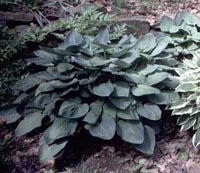Resource Library
Plant of the Week: Royal Standard Hosta
The University of Arkansas System Division of Agriculture does not promote, support or recommend plants featured in "Plant of the Week." Please consult your local Extension office for plants suitable for your region.
Plant of the Week
Royal Standard Hosta
Latin: Hosta plantaginea 'Royal Standard'

Today, every gardener knows of hostas and how to use them in the garden, but it has
only been since the mid-1960's that hostas began to be widely grown. An explanation
of what caused hostas to rise from relative horticultural obscurity to the number
one garden perennial is elusive.
Certainly our gardens are getting more shady, but this is surely only part of the
answer. Probably the major catalyst for the rise in hosta popularity was the dedicated
group of breeders who banded together and promoted their favorite plant, ultimately
leading to the founding of the American Hosta Society in 1968. Once gardeners tried
the newer hostas, they were hooked.
Royal Standard was one of the first new hostas to spur interest in this group of
shade loving perennials. It was introduced in 1965 by Wayside Gardens and remains
one of the most common green-leafed hostas in cultivation.
It is a strong clump forming hosta with foliage around 18 inches tall with clumps
spreading to four feet across. Leaves are on the moderate side, almost never wider
than 5 inches across. White, fragrant trumpet shaped blooms appear in September on
leafy scapes to 24 inches tall. It has good heat tolerance and holds up well throughout
the summer in the south, plus it is cold hardy to at least -10%F.
I’m a sucker for variegation, and I especially like the variegated hostas. In the
shade variegated plants glow as if highlighted by some talented lighting technician.
But, green is good, too. A landscape using too many variegated plants quickly becomes
a jumble, so the use of green-leafed forms such as Royal Standard add elegance to
the garden and serve as a foil for a few variegated plants planted in their midst.
Because the foliage of all hostas die down in the winter, the anticipation of their
emergence in the spring is one of the joys of gardening.
Like many gardeners, I learned perennials by studying the Wayside Garden catalogs.
This venerable old firm was established in Mentor, OH in 1923 by John J. Grullemans,
a nurseryman of Dutch descent. Grullemans originally specialized in bulbs, but within
a few years he expanded into perennials and woody plants. In 1976, Wayside Gardens
began operating as a subsidiary of Park Seed Company in Hodges, S.C., after its sale
a year earlier.
From when they first began offering hostas in the early 1930's until the mid 1950's,
the Wayside catalog listed only five hostas. In 1960, they were up to eight; by 1966
they had a dozen listed. In 1988, when the front cover of their catalog showed a beautiful
garden full of hostas, they listed two dozen selections which is about what they offer
today, but is only a fraction of the 5,000 or so cultivars that have been named in
recent years.
Hosta ‘Royal Standard’, the first patented hosta, is a great landscape plant because
it grows in a wide array of garden conditions and it is a long term garden survivor.
Like all hostas in the South, Royal Standard should be planted where it receives either
morning sun and afternoon shade or light, filtered sun all day. While it will survive
and grow in the worst imaginable clay, it does better and gets larger in better soils.
Once established hostas have good drought tolerance. Division is not necessarily
needed for hosta plantings, unless additional plants are needed for use in other parts
of the garden. Division can be done in the fall or spring, with the fall probably
slightly better. Slugs are the major pest problem of hosta plantings.
By: Gerald Klingaman, retired
Extension Horticulturist - Ornamentals
Extension News - June 9, 2000
The University of Arkansas System Division of Agriculture does not maintain lists of retail outlets where these plants can be purchased. Please check your local nursery or other retail outlets to ask about the availability of these plants for your growing area.